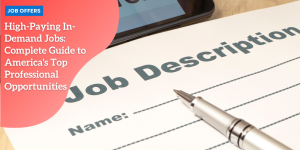How to Write a Career Change Resume: 8 Tips for Success
Understanding Career Change Resumes
Why Traditional Resumes May Not Work for Career Transitions
Traditional resumes often follow a linear career progression, emphasizing titles and dates.
Anúncios
This straightforward format can fail to effectively convey the relevant skills and experiences that are most pertinent when switching industries.
When making a career change, it’s essential to pivot focus from job titles to demonstrated skills and achievements that can transfer across fields.
Unique Challenges Faced When Switching Industries
Career changers frequently grapple with skepticism about their ability to succeed in a new industry.
Anúncios
Hiring managers may question their knowledge of industry-specific tools, terminologies, and workflows.
Additionally, career changers often find it hard to succinctly articulate their value proposition in a way that resonates with an entirely new audience.
Importance of Strategic Resume Formatting for Career Changers
The structure of your resume can significantly impact how well your application is received.
Anúncios
A strategic format that emphasizes transferable skills and relevant accomplishments will help bridge the gap between your past experience and the new role.
Tools like hybrid resumes—which blend functional and chronological elements—allow you to showcase your adaptability and readiness for the career switch while still maintaining a chronological narrative.
Transitioning to a new industry requires a nuanced approach to highlight your potential effectively.
This sets the stage for clarifying your new career direction, which is the next critical step.
Clarifying Your New Career Direction
Conducting Thorough Research About the Target Industry
Before diving into a new career, it is crucial to gather as much information as possible about the target industry.
Begin by exploring industry trends, key players, and common job titles.
Leverage online resources, such as industry-specific websites, trade journals, and LinkedInfluencers, to stay updated with the latest developments and skills in demand.
 Do your research
Do your research
Networking and Informational Interviews with Professionals
Building a robust professional network is vital.
Reach out to industry professionals for informational interviews. These discussions can provide invaluable insights into what it takes to succeed in the new field.
Use platforms like Linked to connect with professionals, join relevant groups, and participate in industry forums and virtual events.
Networking can open doors to opportunities and help you understand the workplace culture better.
Identifying Required Skills and Potential Knowledge Gaps
To succeed in a new career, you need to identify the skills that are essential for the role.
Compare your current skill set with the requirements of the target industry to pinpoint any gaps.
If needed, consider taking relevant courses, earning certifications, or gaining practical experience through internships or volunteer work.
This preparation shows your commitment to the new career and closes the gap between your current abilities and the job requirements.
Wrapping up your research and networking efforts will ensure you have a clear direction and are prepared to articulate why you are a good fit for the industry.
This foundational work will enhance your confidence and enable you to craft a resume that reflects your new career aspirations convincingly.
Identifying and Highlighting Transferable Skills
A successful career change often hinges on clearly showcasing your transferable skills.
It’s essential to identify and highlight those competencies that can be valuable in your new industry.
Here’s how to do it effectively:
Creating a Comprehensive Skills Inventory
| 🛠 Category | 📌 Details |
|---|---|
| 💡 Technical Skills | List programming languages, software expertise, data analysis, industry-specific tools, or any technical proficiencies. |
| 🤝 Soft Skills | Include leadership, teamwork, communication, problem-solving, adaptability, and emotional intelligence. |
| 🎓 Education & Certifications | Mention degrees, diplomas, certifications, and any professional training programs completed. |
| 🏆 Achievements | Document key accomplishments in past roles, major projects, recognitions, and career milestones. |
| 📂 Work Experience | Summarize your professional roles, responsibilities, and contributions in different organizations. |
Mapping Existing Skills to New Industry Requirements
Next, compare your skills with those required in the target industry.
Research job descriptions, industry standards, and expectations to understand what employers are seeking.
Identify the skills you already possess that align with these requirements.
This alignment helps you pinpoint which of your current abilities are directly applicable to your new career path.
Presenting Skills in a Way That Resonates with Hiring Managers
Once you’ve identified your transferable skills, the key is to present them effectively on your resume.
Use language and terminology familiar to hiring managers in the target industry.
For each skill, provide context by describing how you applied it in past roles and the results you achieved.
Quantify your achievements whenever possible, as this helps to substantiate your capabilities with concrete evidence.
By methodically addressing these steps, you set a solid foundation for transitioning to a new career.
This preparation not only helps in resume building but also boosts your confidence as you step into the job market.
Choosing the Right Resume Format
When pivoting to a new career, the structure of your resume can significantly impact how hiring managers perceive you.
Traditional resumes might not effectively present your qualifications for a role in a different industry.
Instead, using a hybrid resume format can provide a well-rounded view of your capabilities and experience.
Benefits of Using a Hybrid Resume Format
A hybrid resume marries the best attributes of the functional and chronological resume formats.
This blend helps highlight your relevant skills while still offering a clear career timeline.
Unlike functional resumes, which can be difficult for Applicant Tracking Systems (ATS) to parse, hybrid resumes maintain the chronological order that hiring managers and ATS favor.
Combining Chronological Experience with Skills-Focused Sections
To construct a hybrid resume, begin with a strong professional headline and a concise career change objective.
Follow this with a “Core Competencies” section listing key skills and expertise using bullet points.
This part should immediately grab attention, demonstrating your qualifications at a glance.
Next, include a “Professional Experience” section, organized in reverse chronological order.
This section should not only cover job titles and companies but also emphasize quantifiable achievements that illustrate your transferable skills.
Be strategic about the experiences you include, ensuring they align with your new career direction.
Structuring Your Resume for Both ATS and Human Readers
Crafting a resume that appeals to both technology and human readers is crucial.
Use industry-specific keywords that you’ve identified through thorough research and job descriptions.
Keywords should naturally integrate into your content, particularly in the “Core Competencies” and “Professional Experience” sections.
Formatting should be clean and consistent, using standard headings, bullet points, and a readable font.
Avoid complicated graphics and tables that may confuse ATS.
By aligning your resume format with these guidelines, you optimize your chances of gaining attention from both ATS and hiring managers, facilitating a smoother transition to your new career path.
Focus on the strategies outlined here to effectively present your hybrid resume, ensuring it caters to the dual audiences of ATS and human readers.
As you tailor each resume, these key elements will enhance its effectiveness, further preparing you for a confident career switch.
Creating an Effective Master Resume
Building a Comprehensive Foundation Document
A key strategy for a successful career change resume is to create a master resume.
This is a foundational document designed with a comprehensive record of your experiences, skills, and accomplishments.
Think of it as a one-stop-shop for everything you’ve done so far.
This document allows you to tailor your resume quickly for different job applications without starting from scratch each time.
Organizing Information for Easy Customization
To efficiently organize your master resume, start by categorizing your information into sections such as professional experience, education, skills, and certifications.
Each section should be thorough and detailed, including dates, job titles, responsibilities, and key achievements.
Make sure to highlight any accomplishments that demonstrate your transferable skills and relevant experience.
This way, when it’s time to apply for a specific role, you can easily pick and choose the most pertinent details to include.
Including All Relevant Experiences and Accomplishments
Include every significant experience, volunteer work, and accomplishment, even if they don’t seem directly related to your target industry.
Focus on how these experiences provided you with transferable skills that are valuable in your new career direction.
Details such as leading a team, managing projects, or enhancing processes can be crucial in showcasing your adaptability and potential.
Creating a master resume isn’t just about listing everything you’ve done; it’s about packaging your diverse experiences to showcase your readiness for a new career path.
Crafting a Compelling Career Change Summary
To make your career change resume stand out, crafting a compelling professional career change resume is key.
Here’s how you can do it:
Writing an Attention-Grabbing Professional Summary
Start with a succinct and attention-grabbing professional career change resume that aligns with your new career goals.
This should address who you are, mention your previous experience briefly, and clearly state your intention to transition into the new industry.
For example: “Motivated project manager with over 10 years of experience in leading cross-functional teams and delivering high-impact projects.
Seeking to leverage my expertise in operations to transition into the sustainability sector.”
Highlighting Relevant Qualifications and Certifications
Next, highlight your qualifications, ensuring they are pertinent to the new industry.
This may include mentioning degrees, certifications, and even relevant coursework or training that demonstrate your formal preparation for the new field.
If you have acquired any new certifications to aid your transition, be sure to include these to show your proactive approach.
Demonstrating Commitment to the New Industry
Showcase your commitment to the new industry in your professional career change resume by mentioning memberships in professional organizations, relevant volunteer work, or participation in industry workshops and conferences.
If you’ve written articles, attended webinars, or completed projects on a freelance basis that relate to the new industry, include these as well.
For example: “Active member of the Green Energy Society and recently completed a certification in Environmental Management.
Volunteered with Eco Volunteers to plant urban gardens.”
By crafting a succinct, focused career transition, you create a strong first impression that can capture the hiring manager’s attention as you take the leap into a new field.
Next, we’ll delve into how to tailor your resume for each position, ensuring it meets the specific demands of your targeted job.
Tailoring Your Resume for Each Position
Incorporating Industry-Specific Keywords and Language
When switching careers, embedding industry-specific keywords into your resume is crucial.
These keywords are often used by Applicant Tracking Systems (ATS) as well as hiring managers to filter out non-relevant applications.
Start by carefully reading job descriptions to identify the most frequent and significant terms.
Incorporate these keywords naturally into your resume, particularly in your professional experience, skills, and professional summaries.
This creates a coherent narrative that aligns with the language hiring managers in your desired industry expect to see.
Customizing Content Based on Job Descriptions
Each job role within an industry might demand slight variations in skills and experiences.
Customize your resume for each application to mirror the job description closely.
Highlight how your background matches the job requirements.
If a position emphasizes project management and you’ve led team initiatives, ensure this experience is front and center.
Where certain skills or experiences are not explicitly asked for, use strategic judgment to include any related and impactful accomplishments.
Selecting Relevant Accomplishments to Feature
Your resume should feature accomplishments that resonate with your target industry.
Consider the results and impacts of your previous roles and how they might translate to the new industry.
Quantify your successes whenever possible—for instance, “increased sales by 20%” or “reduced turnaround time by 30%.” This specificity helps hiring managers see the tangible benefits you could bring to their organization.
Even volunteer work or ongoing education related to the new industry can be instrumental, showcasing your commitment and readiness for the transition.
With a strategically tailored resume, you not only demonstrate your understanding of the desired role but also your dedication and the value you bring.
This tailored approach will help bridge your existing experience with your new career aspirations effectively.
Maintaining Resume Relevance
Focusing on Transferable Achievements and Results
When you’re making a career change, it’s vital to spotlight achievements that showcase your transferable skills.
Focus on accomplishments that have measurable results, as these demonstrate your impact and abilities distinctly.
For example, if you led a project that improved efficiency in your previous role, detail how those skills—like project management and proactive problem-solving—apply to the new industry.
Quantify your achievements with specific metrics whenever possible.
Keeping Content Aligned with Target Industry Expectations
Tailoring your resume for a new industry requires aligning your content with the expectations and language of your target field.
Invest time in understanding the industry-specific terminology, trends, and required skills. Use job descriptions as a guide for the necessary keywords and competencies.
Authentic alignment with industry standards underscores your dedication and readiness for the career shift, making you a compelling candidate.
Seeking Feedback from Industry Professionals or Career Coaches
To ensure your resume is both relevant and impactful, seek feedback from professionals within the industry you’re interested in.
Networking can introduce you to individuals willing to review your resume and provide pointers.
Additionally, career coaches specializing in industry transitions can offer valuable corrective advice.
Their insights can help you fine-tune your resume, ensuring it not only meets industry-specific expectations but also stands out to hiring managers.
By focusing on these strategies, you can keep your resume relevant and tailored to your new career path, enhancing your prospects in landing a role in your desired field.
The process of refinement and customization is essential, but the effort will pay off by making your application resonate with potential employers.
Prepare to leverage these strategies effectively as you navigate through your career transition journey.
Here is another example:





